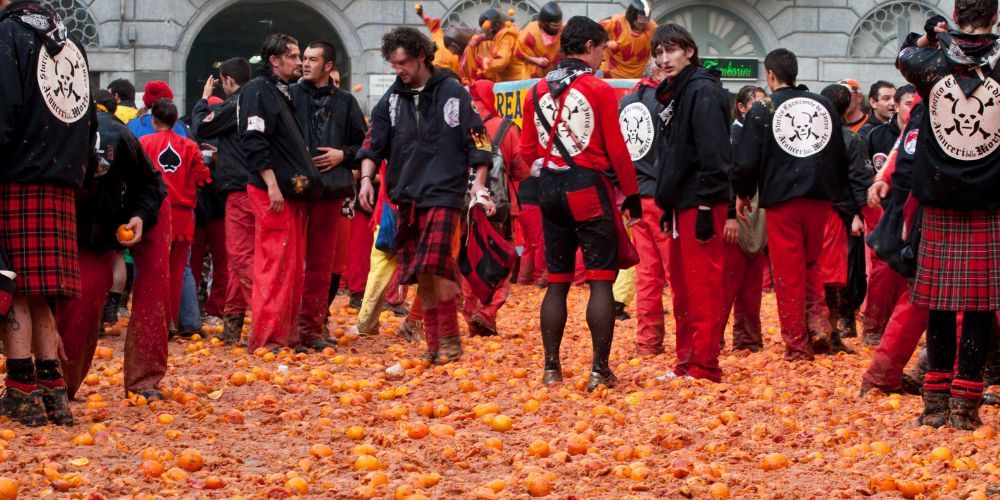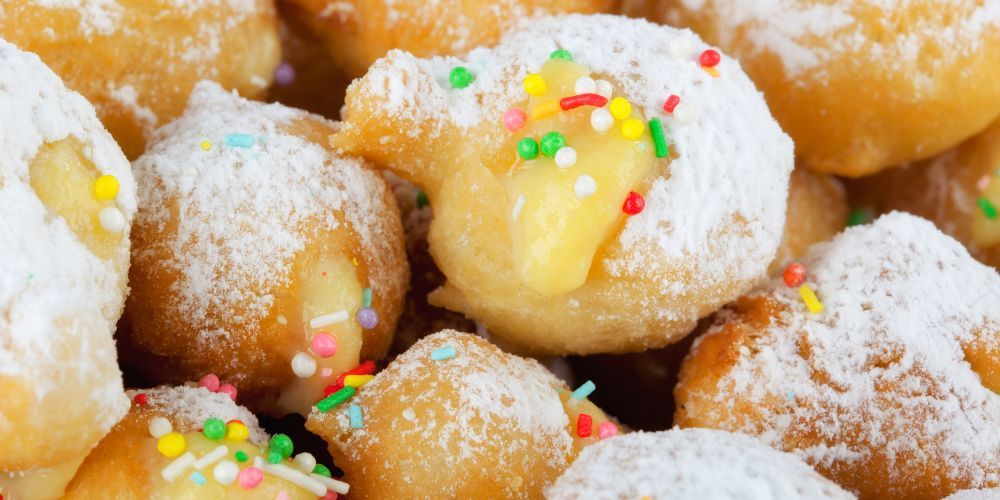There are many curiosities surrounding Carnival in Italy and its origin. For example, we know various theories about the etymology of the word "Carnival." The most common and accepted explanation derives it from the Latin carnem levare, meaning "to remove meat from the diet", popularly translated as "carne-vale." It indicated the last feast based on meat before the fasting period of Lent. Instead, the custom of dressing up, a typical practice of Carnival in Italy (and beyond), dates back to the Paleolithic era. During magical rituals, shamans adorned their bodies with feathers and bells and covered their faces with sacry masks to ward off evil spirits.
Disguises also represent the deeper spirit of Carnival, which is the temporary reversal of order: for a short time, one can become someone else, wearing the clothes of another person.
This tradition also recalls the period of the Roman Saturnalia and the Dionysian cults, during which the transition from winter to spring was celebrated. In this brief period of exuberant festivities and parades, people are free to indulge in excesses and eccentricities. February colors our country with countless parades featuring costumes and allegorical floats. Thus, the theme of reversal remains in the spirit of those who love to celebrate.
Listing all the events held in the thousands of towns and villages across Italy would be almost impossible. However, we highlight some from each region: join us in discovering what happens during Carnival in Italy.

Carnival in Italy: origins, customs and festivities in Rome

Carnival in Italy has arrived once again and we at Visit Italy have selected both historical and lesser-known destinations where you can celebrate and have fun with family and friends. But first, we want to tell you about the origins of this festival in masks.
Most historians trace the origins of Carnival in Italy back to ancient Roman celebrations held in December and March, known as the Saturnalia and Bacchanalia. During the Saturnalia, participants disguised themselves, mocking the subjects of their masks. In particular, slaves would wear their masters' clothes. They also exchanged gifts, called strenae, and performed animal sacrifices to the gods, especially Saturn. The Greek Bacchanalia, dedicated to the god Dionysus (the Roman Bacchus), were true orgiastic festivals intended to ensure prosperous sowing and harvests.
Another widely celebrated event in Rome between the late 1700s and 1800s was the masked parades on Via del Corso during Martedì Grasso (Fat Tuesday), known as "La Festa dei Moccoletti" (Feast of the tiny candles). On the last day of Carnival, all the inhabitants went out, masked, holding a candle and trying to keep it burning. If their candle extinguished, they had to reveal their identity by removing their mask.
Today, Carnival is a Catholic and Christian celebration, but as we have seen, it has very ancient origins. It is different from other festivals is the use of masks and pranks, often accompanied by parades with floats adorned with playful and imaginative elements.
Here, we will tell you about some of the most famous and characteristic Carnivals throughout Italy.
The happiest feast of the year
When Does Carnival 2025 Take Place?
Carnival in Italy is the merriest event of the year and in Italy it takes place in various locations. Across the country, preparations are underway: people wear funny costumes, attend masquerade balls and parades, eat the famous lasagna and traditional sweets, and organize parties while eagerly awaiting the famous Carnival float parades.
Now that we have explored its origins, we want to introduce you to some of the most famous Carnivals in Italy. It would be impossible to list them all, as there are so many, but here is a selection of 11 noteworthy cities, including the most well-known, unique, ancient, and famous ones. Let's discover them together.
Join to the Great Ball of Venice CarnivalFamous Carnivals in Italy

Here are the ones we think you absolutely must know among the Famous Carnivals in Italy:
11. Venice, Veneto
Among the most beautiful cities to visit for Carnival in Italy, Venice must be ranked first. Not only because it is one of the most beautiful carnivals in Italy, but above all because it is one of the most famous and well-known in the world. Typical costumes parade through the canals and evoke the atmosphere of the early 17th century through fine fabrics, period costumes and hand-painted masks, visit the Venice Carnival. A special feature of the Venetian festivities is the Flight of the Angel, which makes everyone turn their noses upwards, as athletes and celebrities glide swiftly through the air from St Mark's Bell Tower to the Doge's Palace.
10. Ivrea, Piedmont
A very special Carnival in Italy is the historic Carnival of Ivrea, known for its Battle of the Oranges and held on Shrove Tuesday.
If you love bizarre traditions, you can't miss this original event. Where every year the crowd throws oranges at the 'oppressors' on horse-drawn carts, thus re-enacting the story of rebellion from an evil tyrant by the young Violetta, later followed by all the citizens and fought, precisely, with oranges!
9. Viareggio, Tuscany
This list of Carnival in Italy cannot fail to include the Viareggio Carnival, associated with the iconic Burlamacco mask, created by the painter and graphic artist Uberto Bonetti in 1930. Its enormous allegorical floats have been the undisputed protagonists of this event for decades now, due to their size and above all their beauty, which is due to the attention to detail on the part of those who create them. In fact, there is a real school of papier-mâché workmanship here; it organises training courses for the youngest, in which Viareggio's master papier-mâché artists teach the secrets of the technique of working paper casts, thus introducing them to this fascinating world.
8. Cento, Emilia Romagna
The Carnival of Cento in Italy is another unique event. It is no coincidence that it is twinned with the most beautiful Carnival in the World, the one in Rio de Janeiro.
Its mammoth allegorical floats, over 20 metres high, are one of the main reasons, but certainly not the only one. The real uniqueness of this event, concerns the throwing, by the masqueraders travelling on the floats, of gifts and gadgets of all kinds to the crowd, such as puppets, balloons and many other surprises.
7. Ronciglione, Lazio
Considered the most beautiful carnival in Italy, the Ronciglione carnival in Lazio is an event full of events and parades, awaited all year round for the beauty and variety of the celebrations. The protagonists of the event are the 'Nasorosso', dedicated to the pleasures of the table and wine and devoted to Bacchus, and the 'Ussari', the Hungarian soldiers of the 15th century.
Carnival in Italy begins with the 'Cavalcata degli Ussari', which commemorates the defence of the Papal States by these horsemen, continues with the 'Corse dei Barberi', also called 'Corse a vuoto', because they are horse races without jockeys, and ends with the 'Nasi Rossi' parade, called 'Pilatata'.
6. Fano, Marche
Did you know that the Fano Carnival was the oldest Carnival in Italy? The earliest documents about it date back to 1347, so we can claim it as the winner of the title of oldest Carnival in Italy, as well as the most important event in the Marche region involving more than 100,000 people every year.
5. Maiori, Campania
In Campania, have you ever seen the Grand Carnival of Maiori, one of the most beautiful in Italy? A tradition deeply felt by the locals, which over the years has grown more and more into a real event.
Every year, the streets are coloured with joy, it is a riot of masks and confetti, here adults become children again. It is not just a moment of entertainment for the little ones, but an event that mixes passion and love for tradition and keeps that irresistible desire to have fun and let loose a little, and wearing a mask becomes easier.
A time when creativity and cooperation reign among the citizens who actively take part in the event, committing themselves a few months beforehand. A true hymn to joy and pure fun, but above all a unique opportunity to experience local traditions at first hand.
4. Putignano, Apulia
In our list of Carnival in Italy, the Putignano Carnival cannot be missing, which holds a special place. Here, too, a school was established to teach papier-mâché, which is known all over the world. Under the supervision of the master papier-mâché artists, they build the 'Paper Giants', which year after year with the most beautiful floats and masks ever are the centrepiece of the event. No wonder it is one of the oldest events in the world, some historians, in fact, date it back to the year 1394.
3. Montescaglioso, Basilicata
The Montescaglioso Carnival in Italy is one of the most beautiful in Basilicata, but also one of the oldest. Its typical characters include Carnevalone, his wife the Quaremma, who carries a swaddled puppet in her arms, and Carnevalicchio. Accompanying them are other minor characters who parade around wearing clothes made of paper, cardboard and pieces of cloth. In short, an event under the banner of recycling, which is born and remains poor, albeit colourful and very lively.
On Shrove Tuesday, on the other hand, there is a parade of large allegorical floats, made by master papier-mâché artists.
2. Acireale, Sicily
In Sicily, the most famous carnival in Italy is that of Acireale, and it is distinguished by its parade of scenic horse-drawn floats that almost always take up current themes and politics.
Over time, the event has been enriched with new elements such as, for example, the flowered floats. Its history goes back a long way, in fact, as early as the 1500s, there was a festival characterised by the custom of throwing rotten eggs and citrus fruits in the streets of the town.
1. Mamoiada, Sardinia
We conclude our list of carnival in Italy with a very characteristic and well-known one.
The Carnival of Mamoiada is characterised by two different figures: the Mamuthones and the Issohadores. They are the main performers and without them this event would have no meaning.
When the procession begins, the Mamuthones move in two parallel rows, while the Issohadores remain at the sides.
The Mamuthones walk slowly and stooped under the weight of the many cowbells they wear and at regular intervals ring them by striking them with their shoulder. The more agile Issohadores pick people out of the crowd and by throwing a string, they take them as prisoners, pulling them to themselves.
Along with this highly suggestive spectacle are the characteristic Sardinian dances, banquets with wine, sweets and food typical of Barbagia, the vast mountainous region that is home to the Sardinian village.
Unlike Christmas, Carnival is a festivity whose date varies from year to year. The beginning of this period is considered to be 70 days before Easter, which is also variable, on what is called Septuagesima Sunday. Easter, in turn, is celebrated after the first full moon of spring. Since it depends on lunar cycles, its date is changeable, and based on that, the date of Carnival is determined.
The 2025 Carnival celebrations in Italy begin in February with Septuagesima Sunday on the 16th, but the festivities reach their peak during the week from Fat Thursday to Shrove Tuesday. Fat Thursday will be on February 27, Carnival Sunday will be on March 2, while Shrove Tuesday will be on March 4. Ash Wednesday, on March 5, marks the end of the festivities and the beginning of Lent, leading up to Easter. Time is running out, so we suggest you start thinking about your costume now!
What you eat at Carnival in Italy: the 7 traditional desserts

The air is filled with excinting aromas, powdered sugar and fried treats are everywhere: this period brings wonderful scents that define the characteristic flavors of Carnival in Italy, a delight for the eyes and especially for the palate.
Carnival is not just about costumes but also about traditional food, an indulgence in rich dishes and drinks, and an excuse to take a break from the usual daily routine. Throughout Italy, from North to South, the holiday is also celebrated at the dining table with traditional Carnival sweets, which allow people to rediscover authentic flavors and ancient traditions.
Here’s a list of seven typical Italian Carnival desserts:
7. Cicerchiata is a well-known dish and a specialty from central Italian regions such as Marche, Abruzzo, Molise, and Umbria. The name of this fried dessert dates back to the early Middle Ages and is believed to derive from cicerchia, a legume similar in shape to a chickpea or a pea. The dish consists of small dough balls made from flour, eggs, butter, and sugar, fried in olive oil, drained, and mixed with honey to create a solid and crunchy structure.
6. Castagnole is another traditional treat from Veneto, Emilia Romagna, and Lazio. These pastries get their name from their original shape, which resembled a small chestnut (castagna in Italian). Over the years, their form has evolved. They have a soft texture and taste best when served fresh and warm. There are different variations: some are filled with cream, ricotta, or chocolate, while others are plain. To add more festivity, they are often flavored with alchermes, a red liqueur poured directly onto the freshly fried castagnole.
5. Frappe are known with many other names —chiacchiere, bugie, frappole, crostoli, and more—depending on the region. They originate from Lazio and Campania but are now widespread throughout Italy. Their history dates back to Roman times when women prepared frictilia, a sweet made with eggs and flour, fried in pork fat. These crispy treats are often attributed to Neapolitan tradition, where they are known as chiacchiere. Legend has it that the Queen of Savoy, tired of endless chatter with her guests, asked her cook to prepare a dessert to quiet them, giving rise to this delicacy. They can be fried or baked and are typically topped with honey, chocolate, or powdered sugar.
4. Graffe come from the Southern Italy and trace their origins to the Austrian rule over Italy in the 18th century. These soft doughnuts are made with flour, sugar, melted butter, and mashed potatoes to enhance their fluffiness. After frying, they are generously coated with sugar. A lighter version exists in which they are baked at 190°C.
3. Apple Fritters are a delicious dessert from Trentino Alto Adige and one of Italy’s typical Carnival desserts. The traditional recipe is based on apples, a hallmark product of the region, which boasts one of the largest apple-growing areas in Europe. The most commonly used varieties for apple fritters are Renetta and Golden apples.
2. Carnival Arancini: these orange-flavored spiral pastries are a specialty of the Marche region, particularly from the province of Ancona. The dough, infused with grated orange zest and sugar, is rolled, fried in hot oil, and topped with colorful sprinkles or powdered sugar. For a lighter alternative, they can also be baked at 180°C for about 20 minutes.
1. Zeppole di San Giuseppe: a true highlight of Italian Carnival desserts, Zeppole di San Giuseppe originate from Naples. Their name might derive from sepulam (meaning serpent) due to their spiral shape or from zeppa, a wooden wedge used by Saint Joseph, a carpenter, to stabilize furniture. According to legend, Saint Joseph was also a fry cook. Initially, zeppole were simple, empty fritters made from flour, water, salt, and a dusting of cinnamon or powdered sugar. The modern Zeppole di San Giuseppe are more decadent, filled with custard and topped with a candied cherry.
Explore Venice during the famous CarnivalCarnival masks in Italy: history and meanings

The long tradition of Carnival masks in Italy has its roots in antiquity. They were made famous by the Commedia dell’Arte and still today represent, each in its own way, a city or region, as well as being a source of national pride.
Some masks are of recent invention, while others were created centuries ago to represent and mock universal human traits and characters.
Let's take a look at the main Carnival masks in Italy, starting from the North and moving towards the South:
- Arlecchino, Brighella, and Meneghino
Arlecchino and Brighella are two masks from Bergamo. Arlecchino has to attend a masquerade at school, but he is a poor child; his mother has no money to buy fabric, so his friends decide to give him scraps from their costumes. Arlecchino's mother sews all the pieces together, creating a colorful outfit—thus, his costume is born. In the Commedia dell’Arte, his character is portrayed as a lazy servant, always plotting some mischief, but his schemes always backfire. Unlike him, Brighella is the classic cunning servant, always ready to deceive others and stir up trouble.
Meneghino originates from Milan and is depicted as a wise man who enjoys mocking the nobility for their vices.
- Colombina and Her Suitor Pantalone
Colombina, traditionally Arlecchino's wife, was born in Venice. She is portrayed as a clever maid, always conspiring against her mistress. Pantalone is another Venetian mask who courts her. His character represents a wealthy merchant, somewhat advanced in age, but who never gives up flirting with every woman he meets. He always carries a purse full of coins and is infamous for his stinginess.
- Gianduja and Captain Spaventa
Gianduja and Captain Spaventa represent the masks of Piedmont (specifically Turin) and Liguria.
Gianduja is a good-natured commoner, a lover of good food and wine, often depicted holding a mug. Cheerful and absent-minded, he frequently finds himself in trouble.
Captain Spaventa, on the other hand, is a boastful swordsman, an arrogant lover who never parts from his sword and prides himself on being a skilled fighter. As a mask, he is presented as pretentious and overbearing.
- Sandrone and Balanzone
Two other historic masks come from Emilia-Romagna. The first, originating from Modena, is Sandrone, who represents a shrewd and cunning peasant of humble origins. One of his distinctive traits is his attempt to sound cultured by using sophisticated language, but he fails miserably, resulting in comical effects.
Balanzone, on the other hand, comes from Bologna. He represents a lawyer or doctor who dispenses advice and tries to appear cultured. However, his Latin is clumsy, and his speeches are long-winded and filled with grandiose but meaningless words.
- Stenterello and Burlamacco
Stenterello is the mask of Florence. Wise and resourceful, he represents the unlucky commoner who, despite his misfortunes, remains cheerful and ready to face life with optimism.
Burlamacco, on the other hand, is the mask of Viareggio, probably the most recently created, dating back to the 1930s. His appearance and costume borrow elements from other masks, and he was conceived as a tribute to Mardi Gras and Italian tradition.
- Rugantino and Meo Patacca
Two Carnival masks also originate from Lazio, specifically Rome.
The most famous is Rugantino, who represents the good-natured commoner. Dressed as a policeman, he is fond of good sentiments and justice but is fundamentally lazy.
His counterpart is Meo Patacca, a troublemaker always armed with a slingshot and a knife. He represents a bully, constantly looking for a fight.
- Pulcinella and Tartaglia
Pulcinella is the famous Neapolitan mask, probably one of the oldest in Italian Carnival history. He is generally depicted as a lazy servant, always looking for tricks to avoid working and make money. Despite this, he is naïve and good-natured. No matter how hard he tries, he always ends up in trouble, but with a bit of ingenuity, he always finds a way out.
A lesser-known Neapolitan Carnival mask is Tartaglia. His character is a stuttering and clumsy lawyer, pompous yet lacking in substance.
- Farinella and Beppe Nappa
Farinella and Beppe Nappa are the symbolic masks of Putignano (in Puglia) and Sciacca (in Sicily), respectively.
Farinella takes its name from a traditional flour of the Apulian town and embodies the characteristics of the local people.
Beppe Nappa, on the other hand, is a lazy servant, dressed in patched and oversized clothes, who is constantly caught and punished for the trouble he causes.
Learn how Venetian masks are createdCarnival celebration in Italy amid traditions and carefreeness
Carnival in Italy may not be known for being the feast of sincerity, but in some ways it is the feast of feasts, during which fun and jokes rule, people get busy creating beautiful costumes, and for one day you can become something you are not. If, on the other hand, you decide to become a “mere” spectator, you can admire wonderful outfits, take part in parades and pageants with fine floats, and enjoy delicious specialties.
Carnival is therefore a perfect opportunity to visit Italy's most beautiful cities and immerse yourself in their traditions, leaving aside for a while the ordinariness, boredom and drudgery of everyday life and getting carried away by the frenzy of the festivities.
Where does Carnival take place in Italy? How many Carnivals are there?
As we have seen, there are many Carnival festivals in Italy that have become famous over the centuries; there are many in many cities in northern and southern Italy, even in small towns and villages that are not present here. Carnival, in short, is a celebration that involves the whole boot.
Which city is home to the most famous Italian Carnival?
The most famous Italian Carnival is undoubtedly that of Venice. But many others compete with it - Viareggio, Ivrea, Putignano, one more beautiful than the other.
Where to see the 2025 Carnival?
All along the Peninsula it is possible to attend Carnival celebrations for this 2025. This year's Venice Carnival will be particularly eventful as we celebrate the 300th anniversary of Casanova's birth. The main theme will be precisely “The time of Casanova”.
Where to see the Carnival floats?
It is impossible to say, among the mentioned Carnivals, which one boasts the most beautiful floats. The most famous and spectacular Carnival floats are in Viareggio, Cento, Putignano and the flowered ones in Acireale.
About the author
Written on 10/01/2023



Simone Spolitu
Let yourself be amazed by the most funny and exciting celebrations ever: discover everything about the Carnival in Italy.